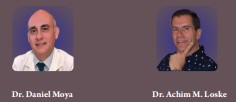Piezoelectric Shock Wave Sources: Are they Still the Cinderella to Treat Musculoskeletal Disorders?
Technical Notes | Volume 2 | Issue 2 | JRS Jul – Dec 2022 | Page 03-06 | Daniel Moya, Achim M. Loske
DOI: 10.13107/jrs.2022.v02.i02.51
Author: Daniel Moya [1], Achim M. Loske [2]
[1] Department of Orthopaedics, Hospital Británico de Buenos Aires, Argentina,
[2] Centro de Física Aplicada y Tecnología Avanzada, Universidad Nacional Autónoma de México,
Blvd. Juriquilla 3001, Querétaro, México.
Address of Correspondence
Dr. Daniel Moya, MD
Department of Orthopaedics, Hospital Británico de Buenos Aires, Argentina.
E-mail: drdanielmoya@yahoo.com.ar
Abstract
There are three types of focused shock wave generators: electrohydraulic, electromagnetic and piezoelectric. Although it has been postulated that there are no differences in clinical efficacy between the three, the information available on the results of the use of piezoelectric generators to treat musculoskeletal disorders is very limited.
The objective of this publication is to demonstrate the little existing evidence on piezoelectric generators and to highlight their versatility and promising future.
Keywords: Musculoskeletal disorders, Shock waves, ESWT, Piezoelectric.
References:
1. Collins English Dictionary. Available from: https://www.collinsdictionary.com/dictionary/english/cinderella [Last accessed on 2022 Feb].
2. Loske AM. Medical and Biomedical Applications of Shock Waves. Cham, Switzerland: Springer International; 2017.
3. Moya D, Ramón S, Schaden W, Wang CJ, Guiloff L, Cheng JH. The role of extracorporeal shockwave treatment in musculoskeletal disorders. J Bone Joint Surg Am 2018;100:251-63.
4. Loske AM, Moya D. Shock waves and radial pressure waves: Time to put a clear nomenclature into practice. J Regen Sci 2021;1:4-8.
5. Schmitz C, Császár NB, Milz S, Schieker M, Maffulli N, Rompe JD, et al. Efficacy and safety of extracorporeal shock wave therapy for orthopedic conditions: Asystematic review on studies listed in the PEDro database. Br Med Bull 2015;116:115-38.
6. National Library of Medicine. National Institutes of Health. Available from: https://www.pubmed.ncbi.nlm.nih.gov [Last accesed on 2022 Jan].
7. Albisetti W, Perugia D, De Bartolomeo O, Tagliabue L, Camerucci E, Calori GM. Stress fractures of the base of the metatarsal bones in young trainee ballet dancers. Int Orthop 2010;34:51-5.
8. Louwerens JK, Sierevelt IN, Kramer ET, Boonstra R, van den Bekerom MP, van Royen BJ, et al. Comparing ultrasound-guided needling combined with a subacromial corticosteroid injection vs high-energy extracorporeal Shockwave therapy for calcific tendinitis of the rotator cuff: A randomized controlled trial. Arthroscopy 2020;36:1823-33.e1.
9. Moya D, Gómez D, Serrano DV, Domínguez PB, Lazzarini ID, Gómez G. Treatment protocol for rotator cuff calcific tendinitis using a single-crystal piezoelectric focused shock wave source. J Vis Exp 2022;190:e64426.
10. Zwerver J, Hartgens F, Verhagen E, van der Worp H, van den Akker-Scheek I, Diercks RL. No effect of extracorporeal shockwave therapy on patellar tendinopathy in jumping athletes during the competitive season: A randomized clinical trial. Am J Sports Med 2011;39:1191-9.
11. Thijs KM, Zwerver J, Backx FJ, Steeneken V, Rayer S, Groenenboom P, et al. Effectiveness of shockwave treatment combined with eccentric training for patellar tendinopathy: A double-blinded randomized study. Clin J Sport Med 2017;27:89-96.
12. PEDro: Physiotherapy Evidence Database. Available from: https://www.pedro.org.au [Last accessed on 2022Jan].
13. Liang HW, Wang TG, Chen WS, Hou SM. Thinner plantar fascia predicts decreased pain after extracorporeal shock wave therapy. Clin
Orthop Relat Res 2007;460:219-25.
14. Bannuru RR, Flavin NE, Vaysbrot E, Harvey W, McAlindon T. High-energy extracorporeal shock-wave therapy for treating chronic calcific tendinitis of the shoulder: A systematic review. Ann Intern Med 2014;160:542-9
15. Bechay J, Lawrence C, Namdari S. Calcific tendinopathy of the rotator cuff: A review of operative versus nonoperative management. Phys Sportsmed 2020;48:241-6.
16. Thiele S, Thiele R, Gerdesmeyer L. Lateral epicondylitis: This is still a main indication for extracorporeal shockwave therapy. Int J Surg 2015;24:165-70.
17. Sansone V, Ravier D, Pascale V, Applefield R, Del Fabbro M, Martinelli N. Extracorporeal shockwave therapy in the treatment of nonunion in long bones: Asystematic review and meta-analysis. J Clin Med 2022;11:1977.
18. 23rd 2021 International Society for Medical Shockwave Treatment Congress. Available from: https://www.shockwavetherapy.org/fileadmin/user_upload/dokumente/PDFs/ISMST_2021_abstractbook_web.pdf [Last accessed on 2022 Feb].
19. Külkens C, Quetz JU, Lippert BM, Folz BJ, Werner JA. Ultrasound-guided piezoelectric extracorporeal shock wave lithotripsy of parotid gland calculi. J Clin Ultrasound 2001;29:389-94.
20. Duarsa GW, Tirtayasa PM, Duarsa GW, Pribadi F. The efficacy and safety of several types of ESWL lithotripters on patient with kidney stone below 2 cm: A meta-analysis and literature review. Teikyo Med J 2022;45:5613-24.
21. Rabenstein T, Radespiel-Tröger M, Höpfner L, Benninger J, Farnbacher M, Greess H, et al. Ten years’ experience with piezoelectric extracorporeal shockwave lithotripsy of gallbladder stones. Eur J Gastroenterol Hepatol 2005;17:629-39.
22. Muller-Ehrenberg H, Licht G. Diagnosis and therapy of myofascial pain syndrome with focused shock waves. Med Orthop Tech 2005;5:1-5.
23. Broegaard A. Extracorporeal shockwave therapy in the treatment of bone disorders: Fracture nonunions, delayed unions, chronic stress fractures and bone marrow edema: A case report series in a private practice setting. J Fract Sprains 2021;2:1008.
24. Moya D, Rodríguez G. Focused Shockwaves in Dental Pathology-Preliminary Report. ISMST22-0038Use. p. 37. Available from: https://www.ismst2022.com/wp-content/uploads/2022/09/ISMST202-programme-and-abstract-book.pdf [Last accessed on 2022 Jan].

| How to Cite this article: Moya D, Loske AM |Piezoelectric Shock Wave Sources: Are they Still the Cinderella to Treat Musculoskeletal Disorders?. | Journal of Regenerative Science | Jul – Dec 2022; 2(2): 03-06. |

